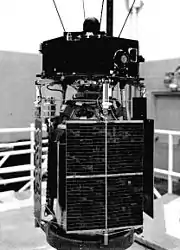Explorer 41
Explorer 41, also called as IMP-G and IMP 5, was a U.S. satellite launched as part of Explorers program. Explorer 41 as launched on June 21, 1969 on Vandenberg AFB, California, United States, with a Delta rocket. Explorer 41 was the fifth satellite of the Interplanetary Monitoring Platform.[5]
 Explorer 41 (IMP-G) | |||||||||||||||||||||||||
| Mission type | Space physics | ||||||||||||||||||||||||
|---|---|---|---|---|---|---|---|---|---|---|---|---|---|---|---|---|---|---|---|---|---|---|---|---|---|
| Operator | NASA | ||||||||||||||||||||||||
| COSPAR ID | 1969-053A[1] | ||||||||||||||||||||||||
| SATCAT no. | 3990[2] | ||||||||||||||||||||||||
| Mission duration | 3 1⁄2 years | ||||||||||||||||||||||||
| Spacecraft properties | |||||||||||||||||||||||||
| Manufacturer | GSFC | ||||||||||||||||||||||||
| Launch mass | 175 kg (386 lb) | ||||||||||||||||||||||||
| Start of mission | |||||||||||||||||||||||||
| Launch date | June 21, 1969, 08:47:58 UTC[3][4] | ||||||||||||||||||||||||
| Rocket | Delta E1 482/D69 | ||||||||||||||||||||||||
| Launch site | Vandenberg SLC-2W | ||||||||||||||||||||||||
| End of mission | |||||||||||||||||||||||||
| Decay date | December 23, 1972[2] | ||||||||||||||||||||||||
| Orbital parameters | |||||||||||||||||||||||||
| Reference system | Geocentric | ||||||||||||||||||||||||
| Regime | Highly Elliptical | ||||||||||||||||||||||||
| Eccentricity | 0.89132[1] | ||||||||||||||||||||||||
| Perigee altitude | 3,920 km (2,440 mi)[1] | ||||||||||||||||||||||||
| Apogee altitude | 172,912 km (107,443 mi)[1] | ||||||||||||||||||||||||
| Inclination | 85.1°[1] | ||||||||||||||||||||||||
| Period | 4,840.9 minutes[1] | ||||||||||||||||||||||||
| Epoch | June 21, 1969[1] | ||||||||||||||||||||||||
| Instruments | |||||||||||||||||||||||||
| |||||||||||||||||||||||||
Spacecraft and mission
Explorer 41 was a spin-stabilized satellite placed into a high-inclination, highly elliptical orbit to measure energetic particles, magnetic fields, and plasma in cislunar space. The line of apsides and the satellite spin vector were within a few degrees of being parallel and normal, respectively, to the ecliptic plane. Initial local time of apogee was about 1,300 hours. Initial satellite spin rate was 27.5 rpm.
The basic telemetry sequence was 20.48 seconds. Data transmission was nearly 100% for the spacecraft life except for the interval from November 15, 1971, to February 1, 1972, when data acquisition was limited to the vicinity of the magnetotail neutral sheet.
It recorded important data on one of the most potent solar proton events of the Space Age in early August 1972.[6]
Explorer 41 functioned very well from launch until it decayed from orbit on December 23, 1972[1][5]
References
- "IMP-G". NSSDC Master Catalog. NASA Goddard Space Flight Center. Retrieved June 18, 2018.
 This article incorporates text from this source, which is in the public domain.
This article incorporates text from this source, which is in the public domain. - "EXPLORER 41 (IMP-5)". n2yo.com. 2011. Retrieved June 18, 2018.
- McDowell, Jonathan. "Launch Log". Jonathan's Space Page. Retrieved June 18, 2018.
- Lafleur, Claude (2010). "Explorer 41 / IMP-5". Spacecraft Encyclopedia. Retrieved June 18, 2018.
- Wade, Mark (2011). "IMP". Encyclopedia Astronautica. Retrieved June 17, 2018.
- Knipp, Delores J.; B. J. Fraser; M. A. Shea; D. F. Smart (2018). "On the Little‐Known Consequences of the 4 August 1972 Ultra‐Fast Coronal Mass Ejecta: Facts, Commentary and Call to Action". Space Weather. 16. doi:10.1029/2018SW002024.
.png.webp)